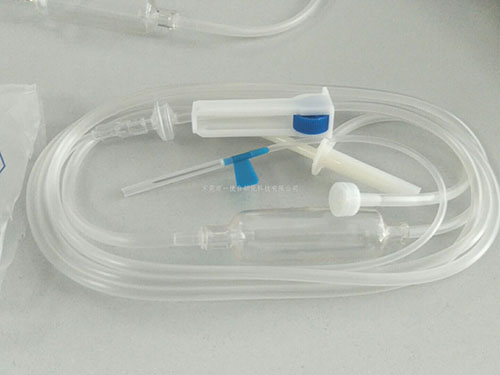
 选血管老年人——手足背Intravenous infusionElderly, frail and suffering from a variety of chronic diseases, the hand and foot veins are small and shallow, less subcutaneous fat, poor elasticity, lack of blood vessels to support tissue, greater mobility, and difficult puncture. Therefore, before puncture, we should carefully understand the characteristics of blood vessels or physiological abnormalities, and we must pay attention to make it fully exposed, see the depth and thickness of the walk. According to hand and footPeripheral nerveIt is more sensitive to pain stimulation, and the needle should be gradually injected with fast, steady, accurate and shallow rather than deep methods to avoid blood vessel constriction caused by pain and reduce the success rate of puncture. Compare the length of the needle body and blood vessel to determine the length of the needle. Patients do not need to clench their fists during puncture, and natural relaxation method is obviously superior to clenching method, which has the advantages of fast injection, fast blood return and high point-to-point blood rate, and significantly reduces the pain of injection. During intravenous infusion, the patient's hand or foot should be held with his left hand, and the lower end of the blood vessel should be fixed with the skin tightened with the thumb to reduce the sliding of the blood vessel. If the site is difficult to puncture, the blood vessel from 1/2 of the back of the hand and foot to the finger can be retrograde puncture.
选血管老年人——手足背Intravenous infusionElderly, frail and suffering from a variety of chronic diseases, the hand and foot veins are small and shallow, less subcutaneous fat, poor elasticity, lack of blood vessels to support tissue, greater mobility, and difficult puncture. Therefore, before puncture, we should carefully understand the characteristics of blood vessels or physiological abnormalities, and we must pay attention to make it fully exposed, see the depth and thickness of the walk. According to hand and footPeripheral nerveIt is more sensitive to pain stimulation, and the needle should be gradually injected with fast, steady, accurate and shallow rather than deep methods to avoid blood vessel constriction caused by pain and reduce the success rate of puncture. Compare the length of the needle body and blood vessel to determine the length of the needle. Patients do not need to clench their fists during puncture, and natural relaxation method is obviously superior to clenching method, which has the advantages of fast injection, fast blood return and high point-to-point blood rate, and significantly reduces the pain of injection. During intravenous infusion, the patient's hand or foot should be held with his left hand, and the lower end of the blood vessel should be fixed with the skin tightened with the thumb to reduce the sliding of the blood vessel. If the site is difficult to puncture, the blood vessel from 1/2 of the back of the hand and foot to the finger can be retrograde puncture.
Pediatric scalp-intravenous retrograde infusion method usually pediatric scalp intravenous infusion uses centripetal reverse行venipuncture,However, children with long-term transfusion can not recover in a short time due to more vascular damage, such as using punctured blood vessels for transfusion, due to localThe blood volume increases, the intravascular pressure increases, and the liquid can penetrate into the tissue space through the original needle eye to cause local swelling, which can be caused by some drugs such as infiltration under the skinTissue necrosis , causing undue pain to the child. There was no reticular shunt of scalp veins in childrenVenous valve , retrograde infusion speed does not slow down.
The closed infusion method utilizes the original sealed bottle intubation infusion method, which is easy to operate and has less pollution opportunities, and is widely used in clinical practice.
Open infusion method can flexibly change the type and quantity of infusion, and add various drugs at any time as needed. Critical rescue, surgical patients and sick children often use this method, but it is easy to pollute, so it should be strictly implementedAseptic technology Operating requirements。
 Intravenous indent needle Intravenous indent needle is suitable for long-term intravenous infusion, old age, failure, vascular puncture difficulties. By the needle part withThe heparin cap consists of two parts: the needle part is a soft silicone catheter followed by a hard plastic blood return chamber partStainless steel wire guide needle, guide needle tip protruding soft silicone catheter needle part Heparin part: hard plastic piston at the front end, rubber cap closed at the back end. There is a hollow tube in the cavity of the heparin cap that can contain heparin.
Intravenous indent needle Intravenous indent needle is suitable for long-term intravenous infusion, old age, failure, vascular puncture difficulties. By the needle part withThe heparin cap consists of two parts: the needle part is a soft silicone catheter followed by a hard plastic blood return chamber partStainless steel wire guide needle, guide needle tip protruding soft silicone catheter needle part Heparin part: hard plastic piston at the front end, rubber cap closed at the back end. There is a hollow tube in the cavity of the heparin cap that can contain heparin.
The subclavian vein is located below the back of the clavicle. This vein is superficial, thick, and as thick as the thumb for adults. It has fast blood flow and is often in a full state, so it is easy to puncture. Puncture site: The Angle formed by the lateral margin of the sternocleidomastoid muscle and the clavicleThe bisector is 0.5-1cm above the vertex.
External jugular vein puncture intubation infusion is the largest in the neckThe superficial vein , located under the skin of the lateral neck, is relatively fixed and can be transfused. However, it is not advisable to puncture multiple times. Therefore, medical human bodies are chosenThe silicone tube is inserted into the vein. It can be retained for a longer period of time to ensure treatment. Puncture site: near the midclavicular point superior margin withUpper 1/3 of the mandibular Angle line, lateral margin of the external jugular vein.
(1)Strictly enforce“Three checks and seven pairs "system to prevent errors.
(2)Strictly enforceAseptic operation,Prevent complications。Infusion setThe infusion should be absolutely sterile, and the infusion set should be replaced after continuous infusion for more than 24 hours.
(3)preventAir embolism。When infusion, the internal air must be drained to prevent the liquid from flowing empty; Replace the infusion bottle and add the liquid medicine in time, and remove the needle in time after the infusion.
(4)Pay attention to the infusion situation. Needle slip, local swelling, yesInfusion reaction。
(5)Look outDrug compatibility contraindication. Antibiotics should be used on the spot;Penicillin G sodium (potassium) salt withtetracycline、When Erythromycinis used together, precipitation, turbidity and discoloration may occur, and the potency may be reduced. When tetracycline and vitamin C need to be added at the same time in the infusion, the tetracycline should be dissolved and diluted first, and then vitamin C should be added.
(6)Pay attention to protecting blood vessels. For long-term infusion recipients, measures can be taken:
① The veins of the limbs start from the distal venules, alternating hands and feet.
② Master three links during puncture; Vein selection should be accurate; Puncture should be steady; The needle should be fixed firmly to improve the puncture success rate.
③ Add drugs that are highly irritating to blood vessels into the infusion, such as erythromycin, etc., should be added after successful puncture, should be fully diluted, and a certain amount should be input after the infusionIsotonic solution to protect veins.
For patients who need to strictly control the drip rate, useInfusion pumps are a major advance in safe infusion and can be divided into two main types; ① Portable or semi-portable. Suitable for family, children and chemotherapy patients, with pumpSyringes belong to this type. ② Fixed infusion pump. Currently mostly usedThe third generation computer controls the catheter extrusion fixed volume infusion pump. There are multi-functional monitoring and monitoring system, large volume, suitable for hospitals, infusion capacity range of 1-499ml/ hour, and automatic alarm device.
Indications for the use of infusion pumps; Intravenous high nutrition, the input of chemotherapy drugs, antibiotics and drugs with special effects on cardiovascular, etc., for intensive care patients, especially pediatric care patients. If the above equipment is not available, a sterile needle can be inserted into the dropper to adjust the drop speed
About us
Company Profile Honor Typical Case Corporate imageEquipment display
Powder forming class Medical devices Non standard customized equipmentNews Center
Company News Industry News FAQContact us
TEL: +86 0769-82263072 Contacts: +86 139 2924 7077/Mr. Wei Email: 13929247077@139.com Address: No. 31, Hulin Road, Huaide Community,Focus on us
 YeJet Mobile Station
YeJet Mobile Station WeChat official account
WeChat official account